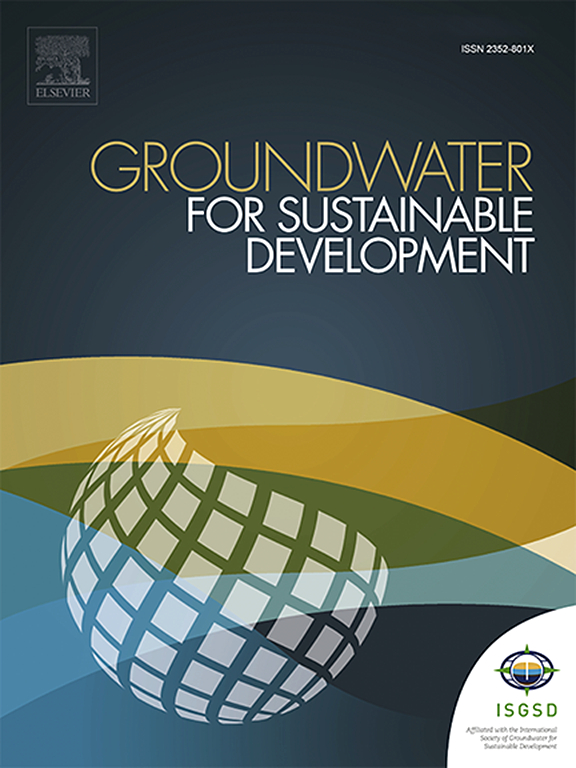Enhancing bioremediation of diesel/biodiesel blend (B20) impacted sites using in situ bioreactors: A nature-based solution for sustainable groundwater management
IF 4.9
Q2 ENGINEERING, ENVIRONMENTAL
引用次数: 0
Abstract
The rise of biodiesel content in diesel/biodiesel blends as a viable alternative to traditional diesel fuel presents several advantages, particularly in terms of reduced emissions of pollutants like carbon monoxide (CO), hydrocarbons (HC), and smoke. However, the increased production and utilization of biodiesel raise concerns about potential environmental impacts, such as groundwater pollution. This has led to a growing need for sustainable and effective bioremediation techniques to address these issues and ensure the safe closure of contaminated sites in accordance with environmental regulatory criteria. Two experimental areas contaminated with B20 (80% diesel and 20% biodiesel v/v) to evaluate ammonium acetate biostimulation (B20_BAA) and natural source zone depletion (B20_NSZD) as remediation strategies were monitored for 10 and 12 years, respectively. Although the benzene half-life was 1.49 and 4.08 years, respectively, hydrocarbon concentrations remained above the maximum contaminant level (MCL) allowed in Brazil for groundwater, requiring additional technologies for site cleanup. Then, two pilot-scale airlift bioreactors were employed as nature-based solutions (NbS) to reduce the concentration of persistent contaminants for site closure. Indeed, concentrations of benzene and 2-methylnaphthalene decreased significantly after the bioreactors began operation, reaching values below their respective MCL. 16S rRNA gene sequencing showed a beneficial response of microbial communities composed of Massilia, Burkholderia-Caballeronia-Paraburkholderia, Mycobacterium and Bacillus genus involved in hydrocarbons aerobic biodegradation. Moreover, predicted functional genes analysis demonstrated that the relative abundances of key aerobic degradation pathways for benzene and 2-methylnaphthalene increased, supporting the hypothesis that the NbS stimulated the hydrocarbons biodegradation. These findings demonstrated that combining different nature-based solutions (NbS) can effectively remediate petroleum hydrocarbons in contaminated groundwater through geochemical characteristics and exploration of indigenous microorganisms. To the best of the authors’ knowledge, this is the first study to employ bioreactors to treat B20-contaminated groundwater at a field scale.

利用原位生物反应器加强柴油/生物柴油混合物(B20)受影响地点的生物修复:基于自然的可持续地下水管理解决方案
柴油/生物柴油混合物中生物柴油含量的增加,作为传统柴油燃料的可行替代品,具有几个优势,特别是在减少一氧化碳(CO)、碳氢化合物(HC)和烟雾等污染物排放方面。然而,生物柴油的生产和利用的增加引起了人们对潜在环境影响的担忧,例如地下水污染。这导致越来越需要可持续和有效的生物修复技术来解决这些问题,并确保按照环境管理标准安全关闭受污染的场地。以B20污染试验区(80%柴油和20%生物柴油v/v)为研究对象,分别监测了10年和12年的乙酸铵生物刺激(B20_BAA)和自然源区枯竭(B20_NSZD)修复策略。尽管苯的半衰期分别为1.49年和4.08年,但碳氢化合物浓度仍然高于巴西地下水允许的最大污染物水平(MCL),这需要额外的现场清理技术。然后,采用两个中试规模的气升式生物反应器作为基于自然的解决方案(NbS),以降低场地关闭时持久性污染物的浓度。事实上,在生物反应器开始运行后,苯和2-甲基萘的浓度显著下降,达到各自MCL以下的值。16S rRNA基因测序结果显示,参与烃类好氧生物降解的微生物群落由Massilia、Burkholderia-Caballeronia-Paraburkholderia、Mycobacterium和Bacillus属组成。此外,预测功能基因分析表明,苯和2-甲基萘的主要好氧降解途径的相对丰度增加,支持NbS刺激碳氢化合物生物降解的假设。这些研究结果表明,结合不同的自然溶液(NbS)可以有效地修复污染地下水中的石油烃,通过地球化学特征和本地微生物的勘探。据作者所知,这是第一个在野外规模上使用生物反应器处理b20污染地下水的研究。
本文章由计算机程序翻译,如有差异,请以英文原文为准。
求助全文
约1分钟内获得全文
求助全文
来源期刊

Groundwater for Sustainable Development
Social Sciences-Geography, Planning and Development
CiteScore
11.50
自引率
10.20%
发文量
152
期刊介绍:
Groundwater for Sustainable Development is directed to different stakeholders and professionals, including government and non-governmental organizations, international funding agencies, universities, public water institutions, public health and other public/private sector professionals, and other relevant institutions. It is aimed at professionals, academics and students in the fields of disciplines such as: groundwater and its connection to surface hydrology and environment, soil sciences, engineering, ecology, microbiology, atmospheric sciences, analytical chemistry, hydro-engineering, water technology, environmental ethics, economics, public health, policy, as well as social sciences, legal disciplines, or any other area connected with water issues. The objectives of this journal are to facilitate: • The improvement of effective and sustainable management of water resources across the globe. • The improvement of human access to groundwater resources in adequate quantity and good quality. • The meeting of the increasing demand for drinking and irrigation water needed for food security to contribute to a social and economically sound human development. • The creation of a global inter- and multidisciplinary platform and forum to improve our understanding of groundwater resources and to advocate their effective and sustainable management and protection against contamination. • Interdisciplinary information exchange and to stimulate scientific research in the fields of groundwater related sciences and social and health sciences required to achieve the United Nations Millennium Development Goals for sustainable development.
 求助内容:
求助内容: 应助结果提醒方式:
应助结果提醒方式:


